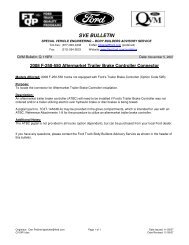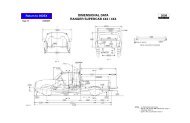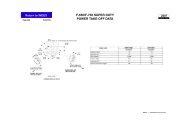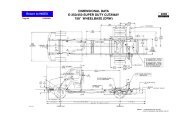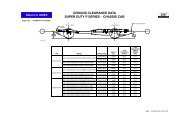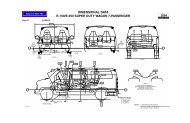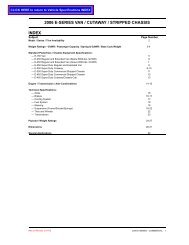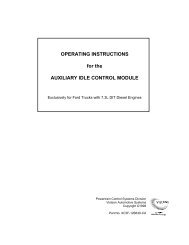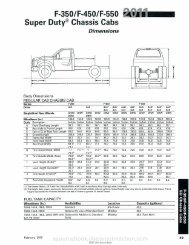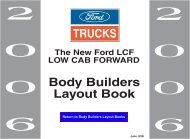2012 super duty f-series incomplete vehicle manual - Ford Fleet
2012 super duty f-series incomplete vehicle manual - Ford Fleet
2012 super duty f-series incomplete vehicle manual - Ford Fleet
You also want an ePaper? Increase the reach of your titles
YUMPU automatically turns print PDFs into web optimized ePapers that Google loves.
210.1 Canadian Requirements:<br />
The statement below is applicable to the Chassis<br />
Cab with a GVWR of 3856 kg [8500 lb] or less and an<br />
unloaded <strong>vehicle</strong> weight of 2495 kg [5500 lb] or less.<br />
This <strong>vehicle</strong>, when completed, will conform to Standard<br />
210.1, User-Ready Tether Anchorages for Restraint<br />
Systems, if:<br />
• No alterations are made to the passenger seat tether<br />
anchorages or LATCH lower anchors, access to the<br />
anchorages is not restricted, and no alterations are<br />
made to the seat assemblies, their anchorages, the<br />
floor pan, or floor pan reinforcements.<br />
212/ Note<br />
219 The terms “body” or “body structure,” in the 212 and<br />
219 statements that follow, include any equipment<br />
permanently attached to that body or body structure<br />
installed by the subsequent stage manufacturer as well<br />
as the basic body or body structure.<br />
212/ INFORMATION<br />
219 Refer to the Design Recommendations section in the<br />
<strong>Ford</strong> Truck Body Builders Layout Book for Second Unit<br />
Body Attachment information to aid in designing second<br />
unit bodies and their attachments for compatibility with<br />
F-Series <strong>vehicle</strong>s.<br />
212/ The statements below are applicable to the Chassis<br />
219 Cab if the GVWR is 4536 kg [10,000 lb] or less:<br />
This <strong>vehicle</strong>, when completed, will conform to Standard<br />
212 Windshield Mounting, and Standard 219, Windshield<br />
Zone Intrusion, if:<br />
• The following windshield system components, related<br />
structural components, and hardware, as installed by<br />
<strong>Ford</strong> Motor Company, are not removed, relocated,<br />
altered, or modified in any way except as specified in<br />
this <strong>manual</strong>:<br />
– Windshield and windshield mounting system<br />
– Cab and front end structural components including<br />
the roof, pillars, cowl, cowl reinforcements,<br />
hood, doors, fenders, hood restrictors and apron<br />
reinforcements, and frame and frame reinforcements<br />
– Radio antenna and air cleaner assembly<br />
– Doors and hood mounting, hinging, and latching<br />
systems<br />
– Hood ornamentation<br />
– Bumper and bumper mounting system †<br />
• No alteration or modification made to the <strong>incomplete</strong><br />
<strong>vehicle</strong> as manufactured by <strong>Ford</strong> Motor Company<br />
and no components or structure installed by a<br />
subsequent stage manufacturer results in any loss of<br />
windshield retention (as defined in Standard 212) or<br />
any penetration of the inner surface of the windshield<br />
or intrusion into the protected zone (as defined in<br />
Standard 219) when the <strong>vehicle</strong> is impacted in any<br />
manner specified by applicable provisions of Standard<br />
212 or Standard 219. Conformity to Standards 212 and<br />
219 for a <strong>vehicle</strong> having an Unloaded Vehicle Weight<br />
greater than 2495 kg [5500 lb] is established by testing<br />
a representative <strong>vehicle</strong> at an Unloaded Vehicle Weight<br />
of 2495 kg [5500 lb] as permitted by S6.1 (b) and S7.7<br />
(b) of Standards 212 and 219, respectively.<br />
F-SERIES (February, 2011)<br />
19<br />
• The front end of the body installed by the subsequent<br />
stage manufacturer is located at least 76.2 mm [3.0<br />
in] rearward of the rearmost point of the cab.<br />
– The body installed by the subsequent stage<br />
manufacturer is mounted securely and so designed<br />
that, when the completed <strong>vehicle</strong> is impacted in<br />
any manner specified by applicable provisions<br />
of Standards 212 and 219, body deformation or<br />
movement relative to the frame does not result in any<br />
separation or loss of body attachment to the frame.<br />
• The maximum SUB weight and SUB center of gravity<br />
as installed by the subsequent stage manufacturer<br />
and the Unloaded Vehicle Weight does not exceed<br />
the values specified in Table F, corresponding to the<br />
<strong>incomplete</strong> <strong>vehicle</strong> type, wheelbase, and engine size.<br />
212/ Canadian Requirements:<br />
219 The preceding statements for FMVSS 212/219 are<br />
appropriate compliance representations for CMVSS 212,<br />
Windshield Mounting, and CMVSS 219 Windshield Zone<br />
Intrusion, if this <strong>incomplete</strong> <strong>vehicle</strong> was manufactured for<br />
sale or use in Canada. In such a case, CMVSS 212 and<br />
219 paragraphs (5.1) and (8)(b) are substituted for the<br />
reference to FMVSS 212 and 219 Sections 6.1(b) and<br />
7.7(b) respectively.<br />
213 The statement below is applicable to the Chassis<br />
Cab:<br />
Conformity with Standard 213, Child Restraint Systems,<br />
cannot be determined based upon the components<br />
supplied on the <strong>incomplete</strong> <strong>vehicle</strong>; accordingly<br />
<strong>Ford</strong> Motor Company makes no representation as<br />
to conformity with this Standard. Any child restraint<br />
system that is added or incorporated into the design<br />
of a designated seating position must conform to the<br />
requirements of this standard.<br />
214 The statements below are applicable to the Chassis<br />
Cab if the GVWR is 4536 kg [10,000 lb] or less:<br />
This <strong>vehicle</strong>, when completed, will conform to Standard<br />
214, Side Impact Protection, if:<br />
• No alterations, modifications, or replacements are<br />
made to the door, surrounding door structure, door<br />
hinges, door latches and strikers, or any attaching<br />
hardware as provided by <strong>Ford</strong> Motor Company.<br />
219 See combined statements under “212/219” for all<br />
<strong>vehicle</strong> types.<br />
225 The statement below is applicable to the Chassis Cab:<br />
This <strong>vehicle</strong>, when completed, will conform to Standard<br />
225, Child Restraint Anchorage Systems, if:<br />
• No alterations are made to the front passenger seat<br />
tether anchorages and access to the anchorages is<br />
not restricted, and no alterations are made to the seat<br />
assemblies, their anchorages, the floor pan, or floor<br />
pan reinforcements, and no seats are added.<br />
Because the addition of seats would change compliance<br />
with this Standard, <strong>Ford</strong> Motor Company makes no<br />
representations as to conformity with this Standard for<br />
any <strong>vehicle</strong> that has seats added by the intermediate or<br />
final stage manufacturers.<br />
† Temporary removal of the front bumper and front bumper<br />
mounting system during manufacture and reinstallation in<br />
accordance with the instructions provided in the <strong>Ford</strong> Truck<br />
Shop Manual should not adversely affect the compliance of<br />
a completed <strong>vehicle</strong> to Standards 212 and 219.<br />
STATEMENTS OF CONFORMITY



